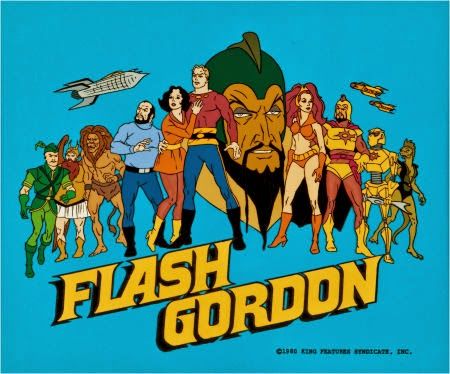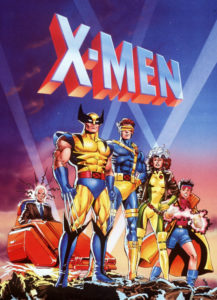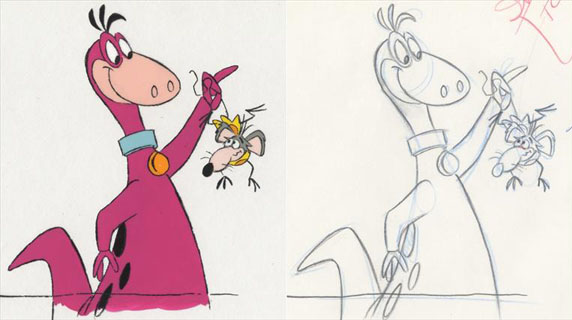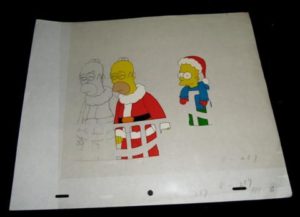
Filmation Flash Gordon. From Mediascene #31 (July 1978), Bob Kline the storyboard supervisor on the Filmation Flash Gordon animated film said, “Flash Gordon is being produced in three essential stages. First, there’s the script stage, where the producers decide what they want to see. This is followed by the storyboard stage, where the director and people like me show them what it will probably look like. After that, the film is in the hands of a half dozen animation directors, each of whom is responsible for directing the production of individual sequences. There are twenty-five sequences in all.
“Flash and his friends encounter a pair of dinosaur-like creatures. I thought the creatures (in the comic strip) drawn by (Alex) Raymond looked too docile. So I based our monsters on those in the Rite of Spring sequence from Fantasia (1940) which featured the best cartoon dinosaur battle ever filmed.”
The model sheets for the characters were done by Herb Hazelton and Carol Lundberg based on artist Alex Raymond’s original designs. Photos of live models and specially constructed props were also used in the production. The script was written by Sam Peeples who had written for the television program Star Trek.
Peoples said he wanted to retain all the fantastic elements of the original comic strip but tie it into the real-life action of World War II that was taking place at the time the strip debuted. When NBC decided that the made-for-television movie should be a series instead, the time period was changed to the current age and the subplot of Ming helping Adolph Hitler was eliminated.
Cute and Vicious. In the Los Angeles Times April 6, 1992 animator and producer Don Bluth said “So many of my contemporaries want to be cute and make movies which are vicious or scary. A lot of times, that’s simply indulging yourself.”
 Loesch Talks X-Men. In the New Jersey Herald and News for July 25, 1993, Margaret Loesch then head of Fox Children Network said, “I’ve been trying to get X-Men on TV for fifteen years. First, when I was at NBC back in the 70s and then when I was president of Marvel Productions. I just couldn’t get any network interested in it. So when I came to Fox, after we got this operation up and running, I called Stan Lee and said, ‘Okay, let’s do it’.
Loesch Talks X-Men. In the New Jersey Herald and News for July 25, 1993, Margaret Loesch then head of Fox Children Network said, “I’ve been trying to get X-Men on TV for fifteen years. First, when I was at NBC back in the 70s and then when I was president of Marvel Productions. I just couldn’t get any network interested in it. So when I came to Fox, after we got this operation up and running, I called Stan Lee and said, ‘Okay, let’s do it’.
“Looking back, this was the best time to do it. It was the right time with all the racial problems and intolerance that people seem to be having. There’s a real positive message with X-Men and we try to deal with it in every episode.
“It’s the single most difficult show to produce in animation or network television right now. It’s got what we call a lot of ‘pencil mileage’, which in animation just means it’s very intricate drawing, a lot of shadows, a very broad color palette.
“We’re also getting a lot of letters from adult men who seem to be enjoying it. Because of the demographics, I have been in discussion with Fox about the possibility of airing X-Men as a special or series of specials in prime time.”
Randy on South Park. In Entertainment Weekly October 14, 2016, South Park creator Trey Parker said, “When we started the show, I would do Randy (Stan’s dad) as an impersonation of my father. Now, it’s just my voice. I’ve become my father.”

Overseas Animation. In the L.A. Times March 30, 1993, an article talked about animation being done overseas. “The Simpsons is drawn in Seoul. Most of a recent cartoon version of The Wizard of Oz was produced in Shenzhen, China. The Flintstones hails from Manila. Winnie the Pooh is painted in Tapei, Taiwan, Teenage Mutant Ninja Turtles is made in Dublin, Ireland. Other familiar cartoons come from Japan, Australia, France and Spain” began the article. There were two reasons for all the foreign work.
“The demand for the shows is so high there just aren’t enough people in the U.S. to do it,” said Colin Baker, head of Toon City Inc. an independent Manila studio.
 The other, and probably primary, reason was cheap labor. It cost about $280,000 to produce a twenty-two minute cartoon in the Philippines. That’s less than half the cost of producing the same animation in Hollywood at the time.
The other, and probably primary, reason was cheap labor. It cost about $280,000 to produce a twenty-two minute cartoon in the Philippines. That’s less than half the cost of producing the same animation in Hollywood at the time.
The downside cartoonists said was that few of the artists in China, Taiwan or Korea speak English. “You’re at the mercy of the translator,” said Wayne Dearing, Fil-Cartoons finance director, a Hanna-Barbera Productions subsidiary in Mandaluyong, a gritty north Manila suburb. “The lip sync comes back way out of sync. They’ve got no idea what it means. No idea.”
One foul up occurred when the Chinese studio was drawing a football game. Since they didn’t play football, the artists kept mixing up the uniforms. That meant the quarterback kept throwing interceptions instead of touchdown passes. And since they’d never seen a football, they colored it Day-Glo orange.
“Drawing the Flintstones is very fulfilling for a Filipino,” said Benjie Agoncillo, the assistant production manager of Fil-Cartoons. “Even if you just draw the mouth of Fred, it’s very exciting. You watch on TV and say, ‘I did that!’.”
Artists were paid for each frame they drew over a set quota so many slept under their desks each night to get an earlier start on the next day. The office was open twenty-four hours a day, seven days a week. Edna Salazar, a painter, camped out three or four nights a week on a fold-up cot. “I earn more that way,” she grins. “They give us coffee and vitamins.”
Belle. From the New York Times November 17, 1991, co-director of Disney’s Beauty and the Beast (1991) Kirk Wise said, “James (Baxter, lead animator for Belle) is sort of a Wunderkind from London. All his work has a balletic, graceful quality to it. Graceful and fluid were the two things we really wanted to get into Belle.”
Baxter had a video segment of ballroom dancers that had been converted into frame-by-frame photos that were taped like a string of paper dolls on the shelf in front of his animation desk. Baxter said, “But basically you have to do it yourself. I figure out which steps I’m going to do first and then quickly sit down and draw before I forget it.
“I’m all right with bodies but the face is very difficult for me. One can’t get cartoonish, especially with the expressions. You can get very ugly very quickly if you put a line in the wrong place. Then what you’re left with is ‘Mildly Attractive and the Beast’.”


 Jim Korkis is an internationally respected animation historian who in recent years has devoted his attention to the many worlds of Disney. He was a columnist for a variety of animation magazines. With his former writing partner, John Cawley, he authored several animation related books including The Encyclopedia of Cartoon Superstars, How to Create Animation, Cartoon Confidential and Get Animated’s Animation Art Buyer’s Guide. He taught animation classes at the Disney Institute in Florida as well as instructing classes on acting and animation history for Disney Feature Animation: Florida.
Jim Korkis is an internationally respected animation historian who in recent years has devoted his attention to the many worlds of Disney. He was a columnist for a variety of animation magazines. With his former writing partner, John Cawley, he authored several animation related books including The Encyclopedia of Cartoon Superstars, How to Create Animation, Cartoon Confidential and Get Animated’s Animation Art Buyer’s Guide. He taught animation classes at the Disney Institute in Florida as well as instructing classes on acting and animation history for Disney Feature Animation: Florida.




















































““You’re at the mercy of the translator,” said Wayne Dearing, Fil-Cartoons finance director, a Hanna-Barbera Productions subsidiary in Mandaluyong, a gritty north Manila suburb. “The lip sync comes back way out of sync. They’ve got no idea what it means. No idea.”
This is true as a general rule, but I thought they spoke English in the Philippines? A company I used to work for did a corporate video where they traveled to three different countries, one of which was the Philippines. It was my job to transcribe the interviews after they returned with the footage. Interestingly, the Filipino interviews were the easiest to transcribe because they actually spoke decent English.
It’s possible the studio in the Philippines just wasn’t very good. There were two episodes of X-Men that were delayed two years when they were sent to Philipine Animation instead of the usual studio (AKOM) (an attempt by Saban to save some money that backfired). The cheaper studio screwed up the episodes so badly that they had to be completely reanimated which was the cause of the delay. (Comparison screenshots can be found here: http://drg4.dancemania-ex.com/xnomutant1.html)
I’m sure that was the advantage a studio like Fil-Cartoons had over others was simply for being a country where English is considered an official language of the country (itself, once a former American colony). I recall Australian animation producer Eric Porter felt that way when he told an interviewer in the 70’s of the works being done in Australia when H-B was sending shows down under.
This is in the category of urban legend now because I knew of someone who was directly or indirectly working for HB. It was Superfriends and the Taiwanese didn’t know who was supposed to be speaking in a shot, so they animated all their mouths to the dialogue.
I think it’s unfair if anyone disparages out-sourced Asian animation these days. It’s been going on for so many decades now, Asian animation studios have really streamlined and honed the process. For many years now many shows look really good. Sadly, we do have tons of animation artists in North America but for producers the actual animation is a means to an end and can’ t seem to be done cheap enough. I wonder if it is now a lost process to do an entire series stateside from beginning to end.
That is something to think about, even if the animation was done using digital tweening/vectors or whatever the latest trends are in the industry. There’s always a reason to not go in-house on a show if one exists.
I love Filmation’s The New Adventures of Flash Gordon! They stayed to the original storyline and characters from the comic strip unlike a newer updated version which came out nearly a decade later that I call the “Gen-X Flash Gordon” which was a complete disaster.
I don’t mind overseas animation as long as it is good, and can understand why TV studios do it. However, for straight-to-video and theatrical films, I don’t see much of a point. Speaking of bad overseas animation, I have to know what your thoughts on this video: https://www.youtube.com/watch?v=nN4MkyfBNac
Runaway production as it was called may have saved studios millions of dollars, but it unfortunately had a body count attached to it. Back then the studios would frequently send skilled American animators to supervise the overseas production, and one of those animators was Fred Hellmich, a Disney veteran who also worked for HB and Ruby-Spears. While in Korea Hellmich became ill and ultimately passed away. Hard to say if things could have been different if Fred’s still in Hollywood animating on PAC-MAN…
I don’t suppose H-B did much to care for his family after his passing. That is pretty sad.
Unfortunately, the Australians’ talents were kind of wasted on those late ’70s/early ’80s HB cartoons, with those shows’ limited animation. It wasn’t until the late ’80s/early ’90s when they began working on Disney TV shows that they really began to shine. When Walt Disney Australia closed in 2006, it was practically the end of an era.
That is very true. People like Porter just didn’t see it the same way others might when it came to the way TV budgets were. Too bad even the attempt at fuller animation was short-lived as you suggest.